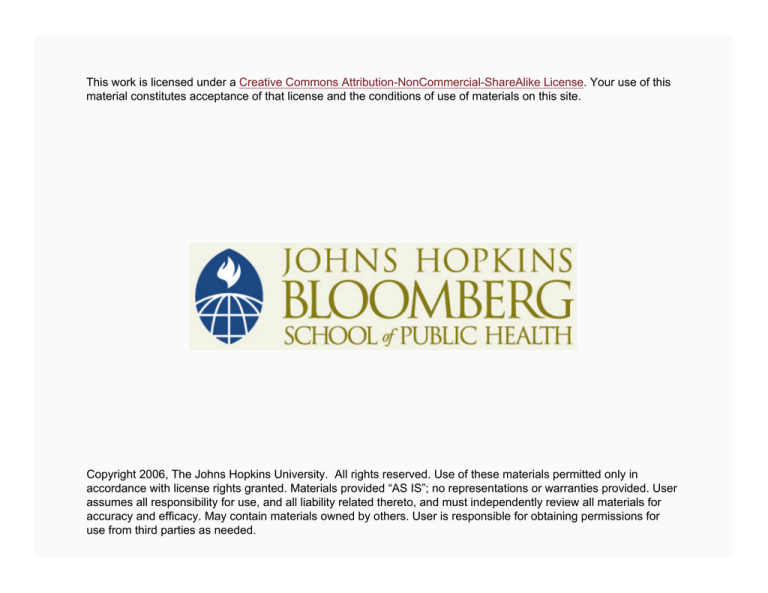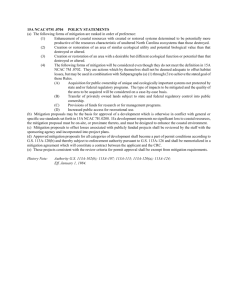
This work is licensed under a Creative Commons Attribution-NonCommercial-ShareAlike License. Your use of this
material constitutes acceptance of that license and the conditions of use of materials on this site.
Copyright 2006, The Johns Hopkins University. All rights reserved. Use of these materials permitted only in
accordance with license rights granted. Materials provided “AS IS”; no representations or warranties provided. User
assumes all responsibility for use, and all liability related thereto, and must independently review all materials for
accuracy and efficacy. May contain materials owned by others. User is responsible for obtaining permissions for
use from third parties as needed.
Improving Understanding and Collaboration
among First Responders
Sheldon Greenberg, PhD
Johns Hopkins University
Maureen Hennessy Benson, MA
Johns Hopkins University
Dave Blodgett, MD, MPH
Southwest Utah Public Health Department
Part Three of Four
Event
Event
There are five distinct stages within a crisis event
− Recognition
− Communication
− Response
− Coordination
− Mitigation
4
Event: Communication
In the communication stage of a crisis event:
− Various groups take action to transfer and exchange
information regarding the crisis
Many weaknesses and challenges exist
− Police, fire, and EMS generally communicate well because
of a shared dispatch center
− Communication between these three and private security
and public health is generally weak
5
Event: Communication—Law Enforcement
The bulk of communication made by law enforcement is via
radio telecommunications
− Problems exist between jurisdictions and between
agencies
6
Event: Communication—Fire Department
Fire departments communication focuses on exchanging
information at the crisis scene
− Can be done many ways (radio, air horns)
− Initially, communication isn’t as important because fire
departments use standard operating procedures
7
Event: Communication—Public Health
Public health personnel communicate:
− Amongst themselves
X Cell phones, satellite uplinks
X Often unreliable, no uniform method
− With the public via risk communication
X Most health departments have one or two
individuals designated to talk with the media
X Public health personnel are also taught the proper
methods to communicate public health impacts of
emergencies via telephone, Internet, or in person
Public health risk communication can be delayed because of
decentralized command and need to create unified message
8
Event: Communication—Private Security
Private security receives threat information from many
sources and communicates them appropriately
− Direct observation
X Will use 911 after detecting a crisis
− Electronically
X Fire alarms send information directly to the local fire
department and the on duty security officer
X Burglar alarms are usually sent to the security officer
and to the alarm company who attempt to contact
the facility/security officer in order to determine if
the alarm is valid
Calling 911 is the primary contact method when a potential
crisis is detected
9
Event: Communication—EMS
In a crisis, EMS is linked directly to the firefighting
communications
− Receives and relays information in the same way as
firefighting
10
Event: Response
The response stage comes after a crisis event has been
recognized and the potential for disaster has been
communicated
The response stage best demonstrates the cultural
differences between groups:
− Fire departments respond as teams
− Law enforcement and private security respond as
individuals
− Public health personnel might respond individually, but
they are supported by a global network of experts and
information
− EMS respond as teams generally
11
Event: Response—Law Enforcement
Police officers take great pride in responding rapidly and
reacting correctly
− Emphasis on rapid response means that they will often be
the first on the scene
If a threat is severe enough, multiple officers, and a supervisor
will be sent to the scene
12
Event: Response—Fire Department
Fire personnel receive extensive training that focuses on a
systematic approach to responding to emergencies
Standard assignments and the Incident Command System
contribute to consistency
Standard procedures can always be augmented if the
situation dictates doing so
13
Event: Response—Public Health
Public health response emphasizes immediate
communication:
− Within the organization (gather help as needed)
− With officials at the community, state, and federal level
− With the public via risk communication
Other public health responses might include:
− Continued surveillance
− Delivering medicine and therapies
14
Event: Response—Private Security
Private security personnel emphasis is on “observe and
report”
− In a crisis, use chain of command to communicate needs
and to describe the situation
Security personnel would also have access to critical
information (for example, closed circuit cameras) that would
improve understanding of the situation
15
Event: Response—EMS
Similar to fire services, EMS training emphasizes a systematic
approach to crisis management
16
Event: Coordination
Coordination is the most challenging, and potentially the
most critical, stage of a crisis
− Demands understanding of other cultures and an
appreciation of the strengths of other groups
17
Event: Coordination—Law Enforcement
Coordination within law enforcement units is often between
specialized units, such as SWAT and hostage negotiation
teams, and the general police force
Little or no training given to typical first responder on
coordination with other first responder groups
18
Event: Coordination—Fire Department
Coordination for fire personnel goes through an established
command post
− Command post provides periodic information updates,
which are given to individual units
19
Event: Coordination—Public Health
The public health workforce is a relative newcomer to
organized first responder group work
− Still serve important coordinating functions in a crisis
Public health personnel also serve in coordinating function
before a crisis
20
Event: Coordination—Private Security
Coordination for private security means assisting in any way
possible
− Probably will not take the lead in a crisis situation, but will
work closely with other first responders
21
Event: Coordination—EMS
Like fire personnel, EMS personnel are trained to report to the
established command post
− Command post will provide periodic updates
22
Event: Mitigation
Emphasis in the mitigation stage is on minimizing loss of life
and property damage
Mitigation could include the following:
− Lockdown
− Protecting a crime scene
− Triage centers
− Complete evacuation of a neighborhood or town
23
Event: Mitigation—Law Enforcement
An important part of police culture is to contain a crisis, which
could include evacuation
Although evacuating others is an important job function and
cultural concern, retreating from a crisis is not in law
enforcement’s cultural code
24
Event: Mitigation—Fire Department
Mitigation for fire personnel is heavily dependent on first
gaining information
− Weather conditions, topography of the area, chemical
nature of a substance (if one is present)
Like police, retreating during the mitigation stage for fire
department personnel is a last resort
25
Event: Mitigation—Public Health
Public health training emphasizes tracking health and
recommending action to help stop the progress of disease or
disrupt its transmission
− As such, they are best suited to work with minimizing
threats posed by bio-terror or chemical warfare agents
Key part of public health mitigation duties is role in
quarantine of patients
Mitigation also means effective risk communication and
mental health response
26
Event: Mitigation—Private Security
As with coordination, private security in the mitigation stage
relies wholly on instructions from other first responder groups
27
Event: Mitigation—EMS
EMS culture is based on mitigation
− Every aspect of their behavior deals with the containment
of injury in order to treat and to transport
28
Event Summary
During a crisis event, five specific stages can be identified:
1. Recognition
X
A crisis is recognized as such, allowing for an appropriate
response
2. Communication
X
Information is transferred or exchanged regarding the
crisis
3. Response
X
Activities performed when responding to a crisis
4. Coordination
X
Probably the most challenging stage
X
Requires multi-jurisdictional and multi-sector
involvement
5. Mitigation
X
Efforts made to minimize property damage and loss of
life
29






